6172RB Science a STEM approach Year 2 low res watermark
You also want an ePaper? Increase the reach of your titles
YUMPU automatically turns print PDFs into web optimized ePapers that Google loves.
Unit overview<br />
Biological sciences<br />
GROWING AND CHANGING<br />
Living things grow, change and have offspring similar to themselves (ACSSU030)<br />
Lesson 1<br />
What is an offspring?<br />
Lesson 2<br />
How do humans grow and<br />
change from a baby to an<br />
adult?<br />
Lesson 3<br />
How do plants grow and<br />
change from a seed to a plant?<br />
Lesson 4<br />
How do offspring that look like<br />
their parents grow and change?<br />
Lesson 5<br />
How do the offspring of frogs<br />
grow and change?<br />
Lesson 6<br />
How do offspring of insects<br />
grow and change?<br />
Summative assessment<br />
<strong>STEM</strong> project<br />
Life cycle map<br />
Students observe living and non-living things, and<br />
discuss what offspring means. Students then scan QR<br />
codes to pair adult animals with their correct offspring<br />
and discuss how the animal is different or similar to its<br />
parent.<br />
Students use time-lapse videos and personal<br />
photographs to explore how humans grow and<br />
change, and how they predict they will look in the<br />
future. Using photographs, students compile a timelapse<br />
video of their own personal growth so far.<br />
Students revise the needs of a plant and explore how a<br />
plant grows from a seed by watching time-lapse videos<br />
linked to QR codes. Students then recreate a growing<br />
plant using a simple stop-motion technique.<br />
Students explore Instagram posts from a zoo and<br />
observe mammals and their offspring. Students<br />
compile a simple digital report to describe how the<br />
animals look at different stages of their life from birth<br />
to young to adult, and how the offspring are similar to<br />
their adult parents.<br />
Students predict how a frog lives two lives and explore<br />
how this relates to the stages of its life by viewing<br />
interactive websites. Students write and draw about<br />
how frog offspring grow and go through complete<br />
changes, and do not <strong>res</strong>emble the adult parents.<br />
Students explore and compare images of various<br />
insects including bees, ants, beetles, ladybugs, flies<br />
and butterflies. Students order the images according<br />
to the predictable stages that each insect goes<br />
through, from egg, to larvae, to pupa to adult, and take<br />
a digital photograph of their work.<br />
Assess students' understanding of the predictable<br />
changes in humans and animals as they grow, and that<br />
some animals have offspring that look similar to the<br />
parents while others don't.<br />
Design and create a mat for a Bee-Bot activity, based<br />
on the changes and growth of a living thing.<br />
Pages<br />
4–7<br />
8–10<br />
11–14<br />
15–17<br />
18–20<br />
21–26<br />
27–28<br />
© R.I.C. Publications<br />
Low <strong>res</strong>olution display copy<br />
29–38<br />
2 <strong>Science</strong>:<br />
A <strong>STEM</strong> APPROACH<br />
YEAR<br />
2<br />
978-1-925431-95-7 R.I.C. Publications® – www.ricpublications.com.au


















